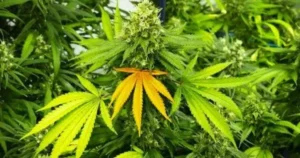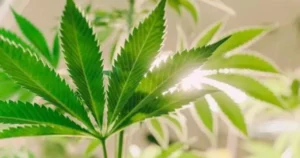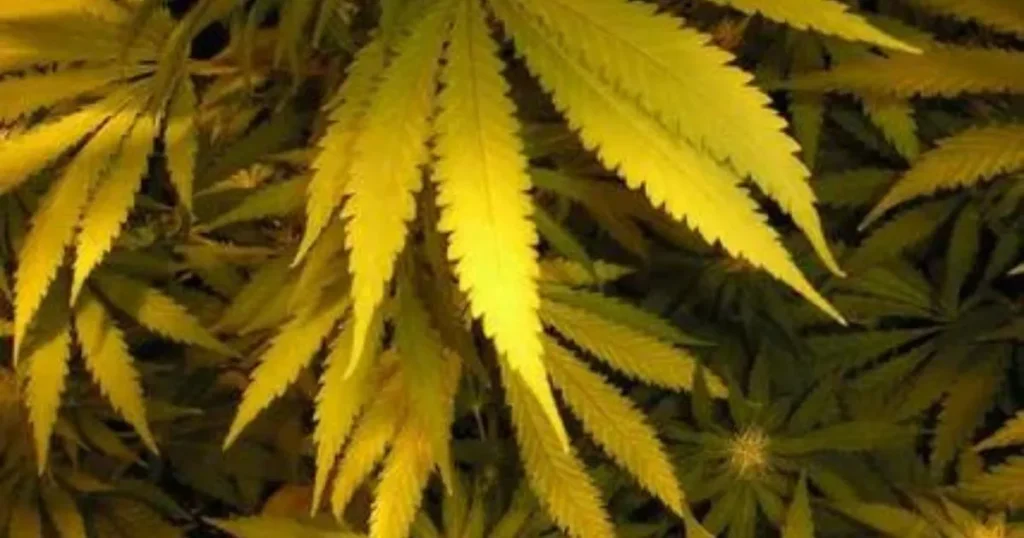Seeing your plants’ once-vibrant green leaves eventually turn yellow can be depressing and frightening for a cannabis farmer. But to solve the problem and guarantee the health and vitality of your crop, you must comprehend the fundamental causes of this phenomenon.
In this article, “Why Are Your Cannabis Leaves Turning Yellow? Causes & Solutions,” we explore the complex world of cannabis production to identify the main causes of leaf discoloration. We examine the reasons behind yellowing leaves and offer doable fixes to help you regain control of your plant’s health, from nutrient shortages to environmental stressors.
This in-depth tutorial is designed to equip all cannabis gardeners, regardless of experience level, with the information and tools necessary to recognize, diagnose, and fix yellow leaves on cannabis leaf problems.
Understanding the Symptoms:
Can have yellow leaves on cannabis in several ways, and each one provides important information about the plant’s general health. The discoloration usually starts at the lower leaves closer to the soil and initially manifests as a slight fading of the green tint. As the disease worsens, the yellowing worsens and moves up the stem, impacting progressively higher levels of the leaves. The affected leaves may have additional symptoms, including leaf curving, browning margins, or obvious wilting.
This distinctive pattern of yellowing from bottom to top indicates inadequacies or imbalances in the plant’s developing environment and acts as a visual cue of nutrient intake and distribution. To restore the plant’s vigor and vitality, it is imperative to comprehend these indications take prompt action, and adopt focused treatments.
Common Causes of Yellowing Leaves:

Cannabis leaves turning yellow can be caused by several things, including environmental stressors or nutritional imbalances. It is crucial to comprehend these typical reasons to properly diagnose and treat the underlying problems.
1. Nutrient Deficiencies: A lack of certain nutrients, such as iron, magnesium, and nitrogen, is one of the main causes of yellowing leaves. Generally speaking, a nitrogen shortage causes the leaves to become yellow, beginning with the lower leaves and moving upward. Interveinal yellowing occurs when there is a magnesium deficit, yet the veins stay green. A lack of iron causes the veins’ interspersed areas to turn yellow, but the veins stay green.
2. Overwatering or Underwatering: Improper irrigation techniques can upset the delicate soil moisture balance, stressing the plant and causing the leaves to become yellow. Underwatering can lead to nutrient deficits and dehydration while overwatering can induce root rot and impair nutrient uptake.
3. pH Imbalance: The ideal pH range for cannabis plants to grow in soil is 6.0 and 7.0. An imbalance in pH can impede nutrition absorption and cause cannabis leaves turning yellow. Alkaline soil (high pH) can prevent the availability of vital nutrients, whereas acidic soil (low pH) can result in nutrient lockout.
4. Pests and Diseases: Plant defenses might be weakened and infestations of pests like aphids, thrips, or spider mites can cause leaf yellowing. Likewise, disorders such as powdery mildew or root rot can hinder the absorption of nutrients and result in discolored leaves.
Finding the exact source of your cannabis plants’ weed leaves turning yellow is essential to putting targeted remedies into place and getting them back to healthy. Growers can avoid yellowing difficulties and encourage strong growth and development by addressing nutritional inadequacies, optimizing watering procedures, maintaining optimum pH levels, and employing pest and disease management strategies.
Solutions for Yellowing Leaves:

To properly address the underlying causes of yellow leaves on cannabis plants, a multidisciplinary strategy is necessary. Your weed plants turning yellow health and vitality can be restored by putting the following strategies into practice:
1. Nutrient Management: Start by determining which of your plants’ nutrient shortages need to be addressed. To remedy deficits like those in nitrogen, magnesium, or iron, think about adding supplements as a balanced fertilizer or specialized nutrient additions. Compost tea and fish emulsion are two examples of organic solutions that might offer a modest but effective nutrient boost to promote healthy growth.
2. Watering Practices: Review your regimen to ensure it satisfies your plants’ requirements without putting them under undue stress. Follow a regular watering schedule to prevent overwatering plan that lets the soil dry out a little in between applications. To precisely determine the soil’s moisture content and modify the watering frequency, think about utilizing a moisture meter.
3. pH Regulation: To promote nutrient absorption and avoid nutrient imbalances, keep the pH levels in your growing medium at ideal ranges. Regularly check the pH of your soil or hydroponic solution and use pH-adjusting products to make necessary adjustments. In soil, aim for a pH range of 6.0 to 7.0; Aim for a slightly lower pH range of 5.5 to 6.5 in hydroponic systems.
4. Pest and Disease Control: Implement integrated pest management (IPM) strategies to prevent and manage pest infestations and diseases effectively. This may include practices such as maintaining a clean growing environment, introducing beneficial insects, using organic pesticides or fungicides, and quarantining affected plants to prevent the spread of pests or diseases.
5. Environmental Optimization: Make sure that the airflow, humidity, and temperature are all suitable for the healthy growth of plants. To reduce the danger of fungal infections and avoid humidity buildup, ensure you have enough ventilation. Keep an eye on the temperature to avoid stress-related yellowing, particularly in intense heat or cold times.
6. Pruning and Maintenance: To stop the development of stress or disease, regularly check your plants for symptoms of yellow leaves on pot plants and remove any afflicted foliage as soon as possible. Additionally, pruning can increase light penetration and ventilation, which lowers the possibility of humidity-related problems and enhances the general health of the plant.
Through the prompt and proactive application of these remedies, you may effectively alleviate yellowing leaves in your weed plants turning yellow and encourage healthy growth and development. Throughout the growth season, keep your plants robust and healthy keep a constant eye on them and modify your care routine as necessary.
Case Studies and Professional Advice (Optional):
Experienced producers’ real-world examples might provide insightful information about how to treat cannabis plants that have fading leaves. One farmer might, for example, describe how they identified a nitrogen deficiency in their plants based on the distinctive yellowing of the bottom leaves and were able to successfully address the problem by using a nitrogen-rich fertilizer. Another grower may talk about how they battled pH imbalances that caused yellowing on their leaves and how they were able to get the pH levels and watering schedule back in harmony. These case studies emphasize the value of proactive management, skilled diagnosis, and careful observation in preserving plant health.
As an alternative, professional advice from knowledgeable growers can offer more direction for keeping weed plants turning yellow in good condition. These pointers could be about boosting soil health with organic nutrient supplements, getting the best possible light and air for healthy development, or taking proactive steps like companion planting to ward off pests naturally. Growers looking to improve their growing methods and routinely produce healthy, bright cannabis plants can benefit greatly from the guidance of experts.
Conclusion:
The reason behind the cannabis leaves turning yellow is critical to keeping your plants healthy and vibrant throughout their growth cycle. You can successfully identify and treat yellowing leaf problems in your cannabis garden by exploring the wide range of potential causes, which include nutritional deficits and environmental stressors. Equipped with an understanding of the signs and typical reasons for yellowing leaves, workable fixes, and professional advice for preserving plant health, you can confidently overcome obstacles and maximize the development and production of your cannabis harvest. To ensure that your cultivation efforts yield the intended outcomes, you must exercise proactive intervention and provide careful plant care to encourage vigorous growth. With the insights gained from this article, you’re well-equipped to overcome yellowing leaf issues and cultivate thriving, vibrant cannabis plants.
Frequently Asked Questions:
1. Why are my cannabis leaves turning yellow?
Yellowing leaves in cannabis plants can be caused by various factors, including nutrient deficiencies, overwatering or underwatering, pH imbalances, pests, and diseases.
2. How do I identify the cause of yellowing leaves in my cannabis plants?
To identify the cause of yellowing leaves, carefully observe the symptoms and consider factors such as the plant’s watering schedule, nutrient regimen, pH levels, and presence of pests or diseases. Conducting soil tests and Examining the plant for indications of injury or stress can also be beneficial pinpoint the underlying issue.
3. What are the common nutrient deficiencies that cause yellowing leaves?
Common nutrient deficiencies associated with yellowing leaves in cannabis plants include nitrogen, magnesium, and iron deficiencies. Each deficiency manifests with specific symptoms, such as overall yellowing (nitrogen), interveinal yellowing (magnesium), or yellowing between the veins (iron).
4. How can I correct nutrient deficiencies causing yellowing leaves?
Correcting nutrient deficiencies involves supplementing the deficient nutrients through organic or synthetic fertilizers. Adjusting nutrient levels in the soil or hydroponic solution based on soil tests or visual symptoms can help restore plant health and prevent further yellowing.
5. What are some tips for preventing yellowing leaves in cannabis plants?
Maintain appropriate watering techniques by making sure the soil is neither too dry nor too wet to prevent yellowing leaves. To ensure ideal nutrient absorption, keep an eye on pH levels and make adjustments as necessary. Use integrated pest management techniques to keep a clean growth environment and reduce the risk of disease. Prevent pest infestations.

